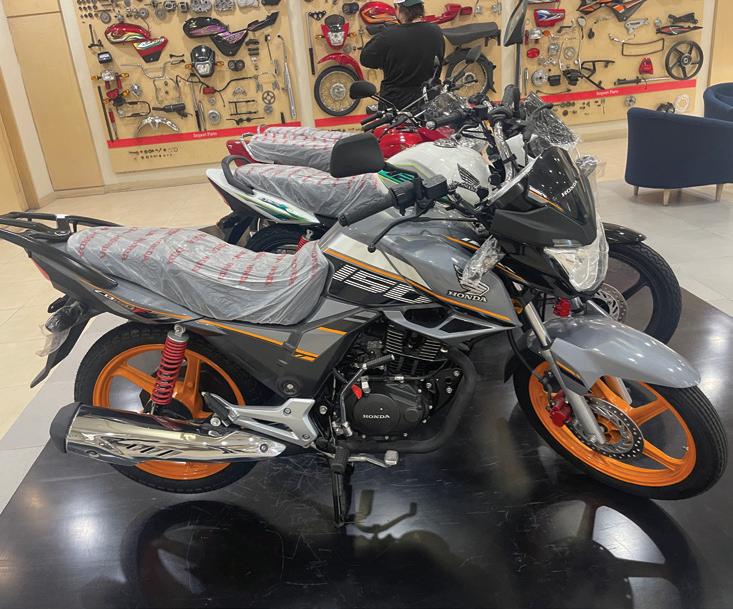
17 minute read
PAKISTAN
Maggie McNally (previous Chair of the AMA Board), Hayley Bell (2019 AMA Motorcyclist of the Year) and Liza Miller (Friend of the AMA award winner) would be traveling to this September with ADA.
Liza was quick to convince me that Pakistan was the ultimate global destination motorcyclists have been missing out on. “If you put every national park in the USA back to back,” she said, “that’s what riding through Pakistan is like. But most people who go there end up saying that the thing they liked most was the culture and people they met along the way.”
ADA is the passion project of Moin Khan, a Pakistani motocross rider and San Francisco State alumni whose goal is to show people the incomparable beauty and hospitality of Pakistan…and change the world’s perspective of his home country, one motorcyclist at a time. In 2011, Moin rode his 2002 Honda CBR600 25,000 miles from San Francisco to Lahore with that goal in mind. The positive reactions and open-mindedness he received from those he met along his around-the-world trip laid the groundwork for building ADA into the full-adventure company it is today.
“Chickistan” is the brainchild of Liza, who after traveling to Pakistan with ADA four times, has become a longtime friend of Moin and shares his passion for dispelling negative stereotypes about the country. After experiencing firsthand how safe and welcoming Pakistan was to women, Liza created Chickistan to encourage female travelers to explore the country’s raw beauty.
Liza has an impressive group to back up these claims. The second Chickistan tour took place several days after U.S. troops pulled out of Afghanistan, an obviously contentious time for that region of the world. Still, the trip was an incredible success, with most of the women going on to spread their stories by speaking at Americade, AMA Vintage Motorcycle Days, Christian Motorcycle Association events, and even on their local news channels. When asked, these women confidently exclaimed that the roads, hospitality, people, and culture were unlike anything they’d experienced before, and that everyone came back with connections that remain strong to this day. About a third of them even returned for the next Chickistan trip.
Enticed by their stories of adventure and the pictures and videos of incredible riding along grand sweeping mountainsides, I decided to trust the judgment of fellow AMA newcomers Hayley and Maggie…and added my name to the list.
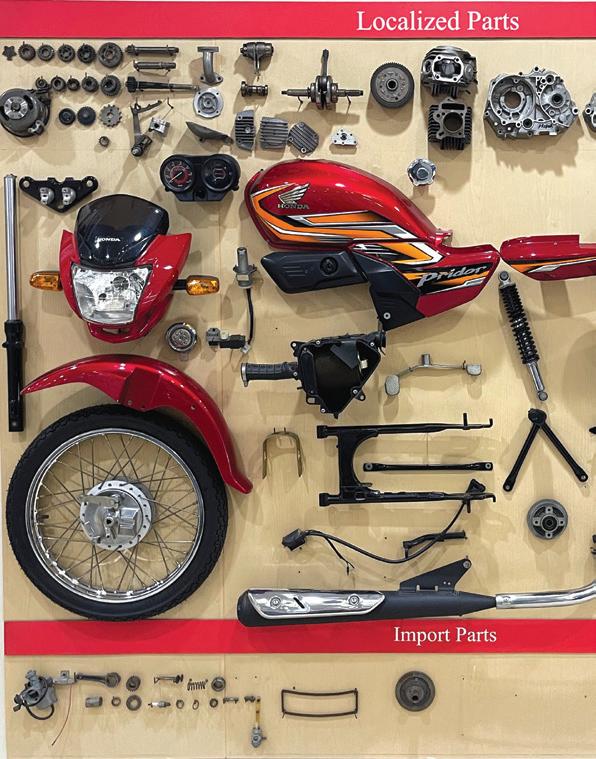
Our group got to tour the Atlas Honda factory, a Pakistani branch of Honda Motor Co. There, they manufacture Atlas Honda bikes, where 98 percent of the parts are made and assembled in Pakistan.
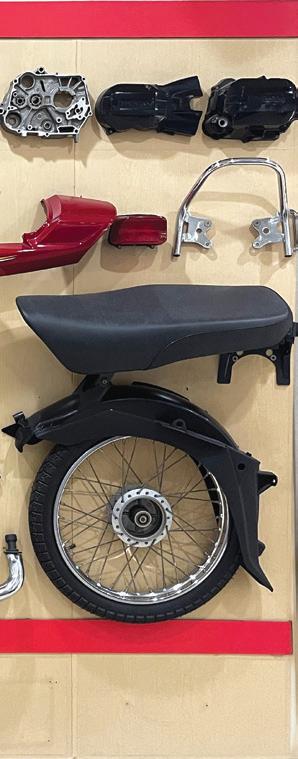
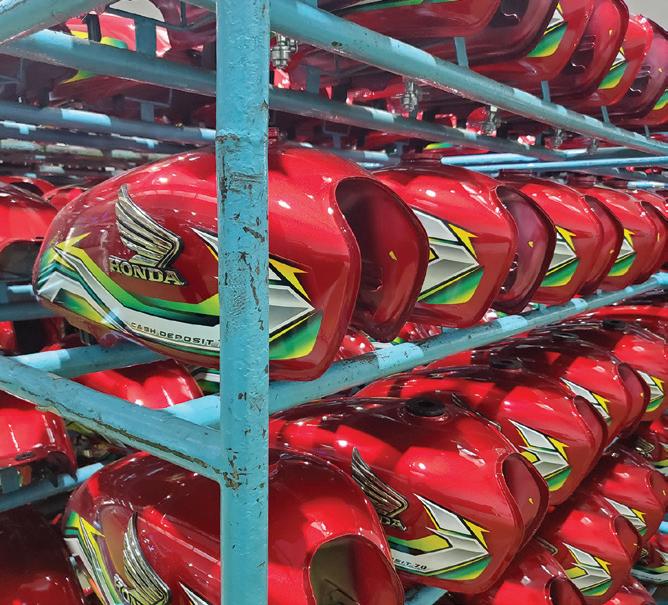
Jaime (on the bike) looks over the edge of Shimshal Valley road, the world’s second most dangerous road. When we encountered this beast, I was armed with a good playlist of curated Pakistani music by Moin’s close friend and famous Pakistani musician Jimmy Khan, as well as plenty of “fake it ’til you make it” confidence. Left: The Atlas Honda factory we toured makes 1.2 million bikes a year. A new bike comes off the assembly line every 24 seconds.
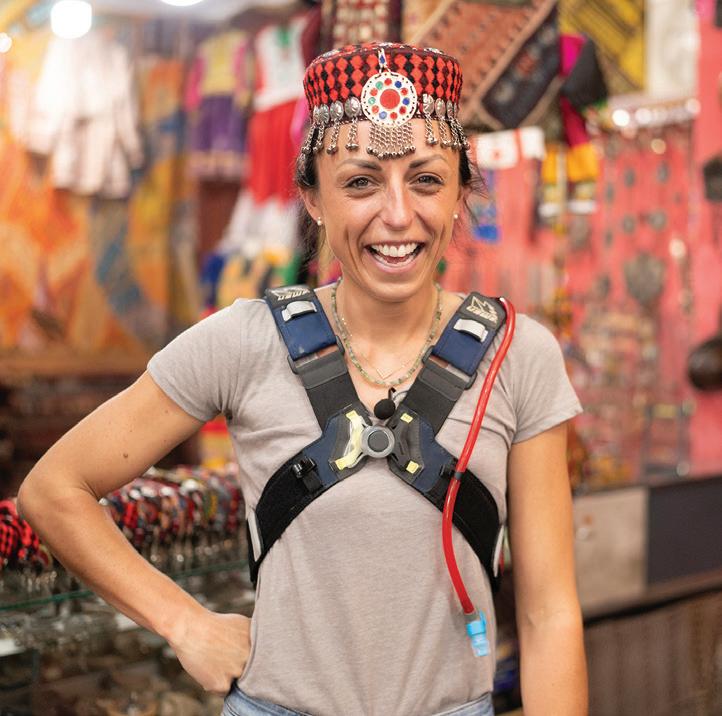
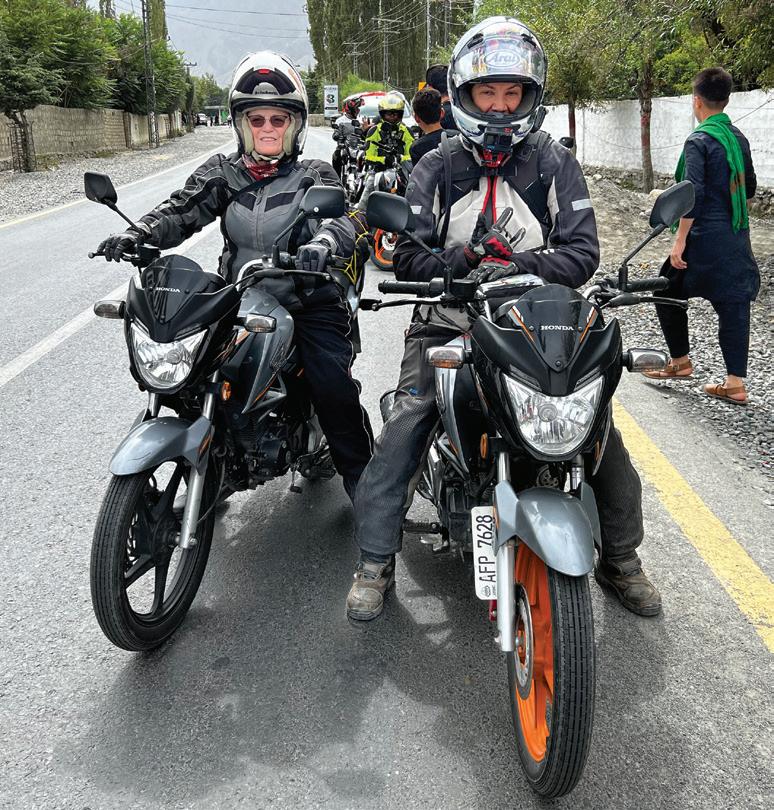
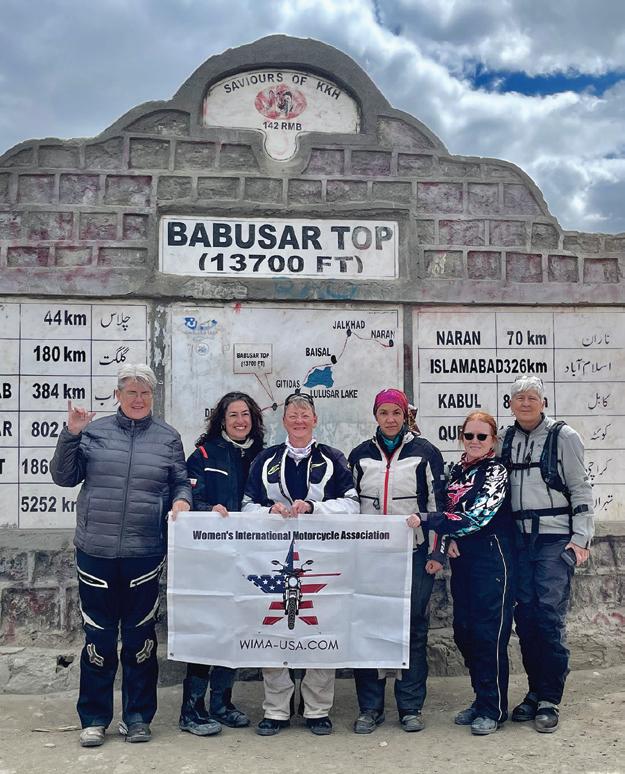
I, of course, had my fair share of ignorant hesitation about traveling to Pakistan, and tried hard not to allow the gossip about a country I have never been to, by people who have also never been there, get to me. The stories of everyone’s overprotective friends and family’s reaction to them going to Pakistan (my mother actually looked into buying kidnapping insurance for me!) became a running joke during our trip, as we experienced nothing but the most welcoming, over-the-top hospitality from every Pakistani local that we met.
“Hospitality is a deep part of Pakistani culture,” Moin explained. “When you come to visit, you’re not just my guest, you’re the guest of everyone, and we take this very seriously.”
I got to experience this unique sense of welcome even before arriving. As the only non-south-Asian person on my flight from Abu Dhabi to Pakistan, I was immediately pulled into conversation by the Pakistani university student sitting next to me, who was extremely excited to hear about my trip. He made sure to recommend the best places to stop in every town on my itinerary and told me that if my group had an extra night in Lahore his family would love to have us over for dinner.
From the moment I stepped off the plane, I was instantly struck by how incredibly appreciative everyone was that we, especially Americans, would be traveling to visit Pakistan. Everywhere we went we were bombarded with requests for selfies, invitations to family dinners, and asked how we liked Pakistan. This led to my second discovery, which is that most of the Pakistani population speaks English. With the third largest Englishspeaking population in the world, the ability to communicate in some form with most people helped ease the culture shock and made finding bathrooms a breeze (always important!).
“When you tell them ‘I’m here from America just to see this country’ and they say thank you, it’s a genuine thank you,” Liza said confidently after experiencing the same reception on all four of her trips. “They know we have overcome misconceptions, we’re not believing what their story has been painted to be, and have decided to come see Pakistan for ourselves.”
This warm welcome didn’t end once we got on two wheels, either. Immediately identifiable as foreigners due to being the only people in full motorcycle gear and wearing helmets, locals would wave to us as we rode past. The best part was the school children, boys and girls whose faces lit up and who would reach out their hands for us to high five from our motorcycles. One kid put so much enthusiasm into his high five that it almost knocked Chickistan alum Lili Dobert off her bike.
We followed a trip itinerary, but Moin’s motto is, “there’s always room for cool people and experiences,” so we often went off map. Moin feels confident letting riders explore Pakistan at their own pace since he’s never had a security risk.
In addition to the natural interest that seeing any foreigners brought, kids were also excited to see us riding the Atlas Honda CB150F, the very first Pakistani-made motorcycle to have a push-button start and usually the largest engine on the road.
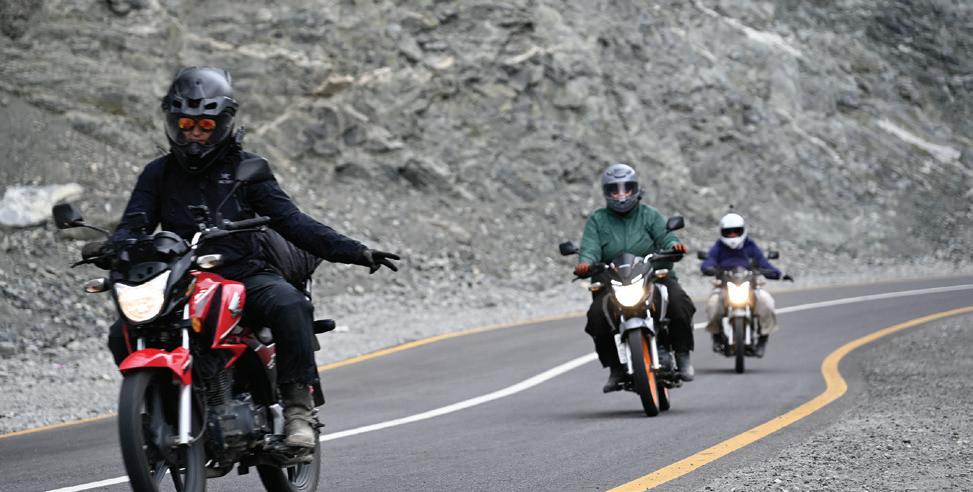
“This is the McLaren of the motorcycle world there,” Liza said, “They weren’t sure if it would succeed because the way the tank is constructed doesn’t allow you to put your children on it — that’s a deal breaker for a lot of families.”
In Pakistan, motorcycles are an everyday part of life. It’s not unusual to see families of four riding on one bike. So when the Atlas Honda CB150F’s design was released, and children could not fit their legs between the tank and the handlebars, it changed this bike’s primary purpose from functional to recreational.
Above: The Wagah border ceremony — an elaborate, twice-aday tradition between Pakistan and India celebrating another day of peace — was a highlight. Right: The world’s highest ATM, sitting 15,394 feet high at Khunjerab Pass. Unfortunately, it didn’t work when we tried to take out money.
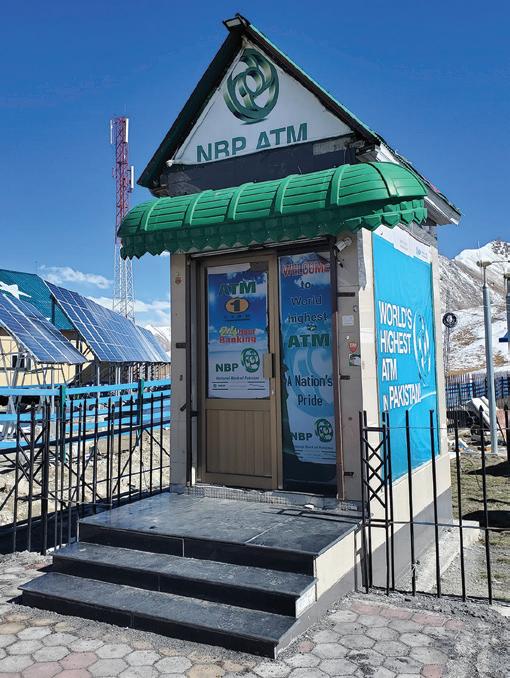
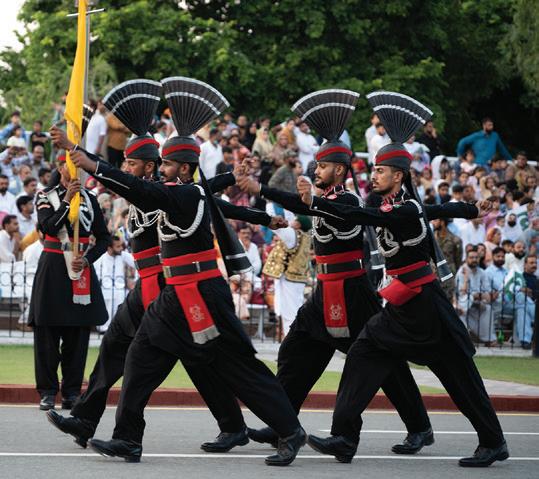
Our group got to tour the Atlas Honda factory, a Pakistani branch of Honda Motor Co. There, they manufacture Atlas Honda bikes, where 98 percent of the parts are made and assembled in Pakistan. Because of this hyper localization they can fully assemble a brandnew motorcycle in under 22 minutes. Walking through the assembly process step by step along the conveyer belt was like stepping into Willy Wonka’s chocolate factory, an absolute giddy delight for any motorcycle fan.
Unsurprisingly, Hondas make up the majority of all the bikes in the country, so much so that Liza started a game called “find the not-Honda!” that we played throughout the trip, where someone would shout out whenever we located a bike of a different brand. This happened very rarely.
While a 150cc motorcycle might not be an American’s first choice for an adventure vehicle, the Atlas Honda bikes are motorcycles made by and for the Pakistani people. They perfectly fit into the way of life and terrain of this beautifully-mountainous country.
As western riders, we’re often told that anything under 500cc is worthless on the highway. As someone whose first bike was a 500cc Buell Blast, who then in less than a year upgraded to the 998cc Buell XB9S, I never even conceived that riding a 150cc bike would be more than enough power to get around some of the world’s most dangerous roads. But that is exactly what these bikes were designed to do. Absolutely bulletproof, the Atlas Honda CB150Fs are the little bikes that could. This bike fearlessly took me over mountains, across gravel plains, through rivers, and past every car on the road.
“The bike is so rugged and stable, it’ll take any beating you give it,” Rachel Stienstra, another repeat Chickistan attendee, said. “I trust these bikes more than I trust my own riding.”
In addition to the Honda CB150F being vastly underpowered compared to American standards, it is also a street bike. With street tires. Which led to some trepidation when traversing some of the most insane off-road terrain
I had ever seen. As someone who’d only sat on a dirt bike once, the learning curve was steep and instant.
Thankfully our trip included Hayley Bell, a famously talented dirt biker who could act as a readily available expert for any questions that came up, no matter how stupid. Quick dirt bike classes happened anywhere from hotel parking lots to mountain plateaus. While gravel roads that end in sheer cliff drops may not be the safest learning environment, they certainly are a motivating one!
As the pride of Pakistani engineering carried us through the country’s northern mountainous terrain, you couldn’t help but fall in love with everything around you. As we wound with the Indus River between mountains its history unraveled around us. Everywhere we looked we caught glimpses of cultures of centuries past.
“What I love about these trips is that we’re in this window of time in Pakistan, where what you’re seeing is not catered for tourism.” Liza says. “We’re invited into people’s lives and get to experience their history and culture firsthand.”
Every riding day the road was filled with picturesque small villages, twisty roads, and breaks for chai tea. Chats with locals often ended with laughter and selfies, and everywhere we stopped seemed to hold a few magical moments just waiting for us to find them.
While every day seemed to push the bar for “the most beautiful thing I’ve ever seen” category in my head, two locations shown through as the highlights of the trip for me.
The first was Deosai National Park, the second highest plateau in the world, with an average elevation of around 15,000 feet. Nicknamed “the land of giants,” Deosai is a dizzyingly vast alpine plain filled with baby head gravel and beautiful lakes. It’s also where I first learned that standing up while riding over loose rocks isn’t an option — it’s a necessity.
Deosai is one of those locations that will always find a way to challenge you.
As someone who’d never been dirt biking before, this was the first true test for me. I was lucky enough to be riding with Liza, an avid and experienced dirt rider, who set a “comfortable” pace of do or die for us. However, Deosai followed the classic truth that the harder something is, the sweeter the reward will be.
After riding about four hours through Deosai, my legs hurt, my head hurt, and I was silently cursing Moin for making us go through this. Then, right as I was about to vocalize those opinions, the mountains opened up before me to reveal the most jaw dropping view of the sunlit Himalayas. I was instantly hit with a wave of euphoria at the sight, and I hated that it made the past hours of abuse completely worth it.
“Taking on Deosai as a 40-year road rider was definitely the triumph of my trip,” Maggie said, who is also a longtime MSF instructor. “Getting to challenge myself in that way, with Hayley cheering me on — that was a blast.”
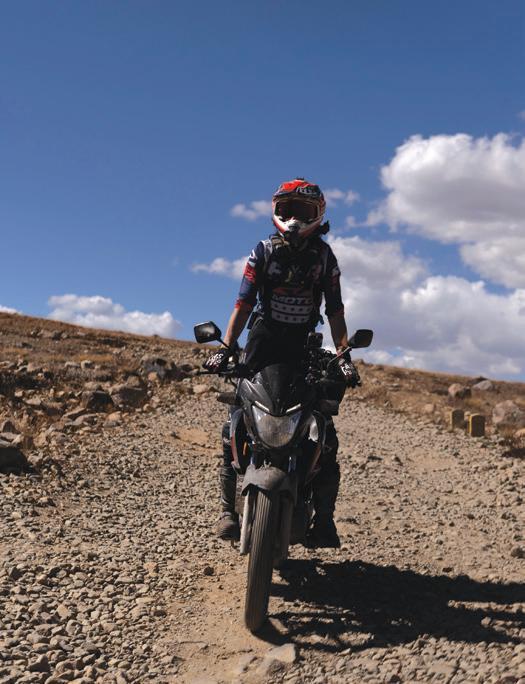
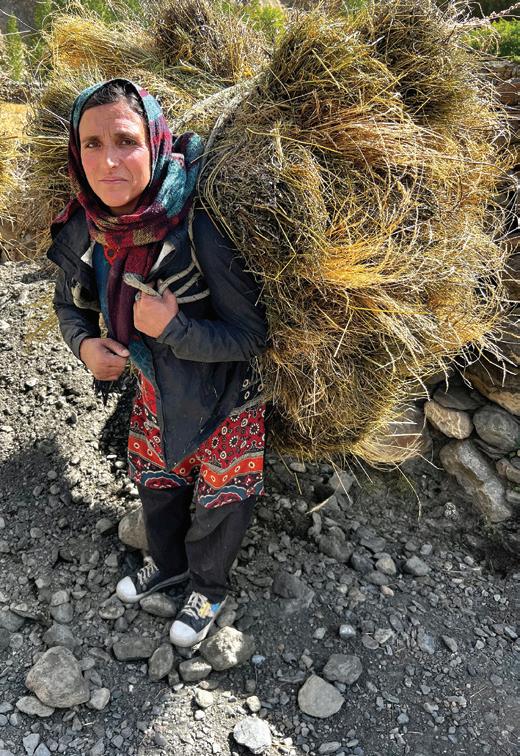
There’s a healthy danger to a lot of the roads in Pakistan. Seemingly impossible when you first look at them, and yet in the next moment you’ve made it through. With faith in your trusty bike and skills, anything became possible.
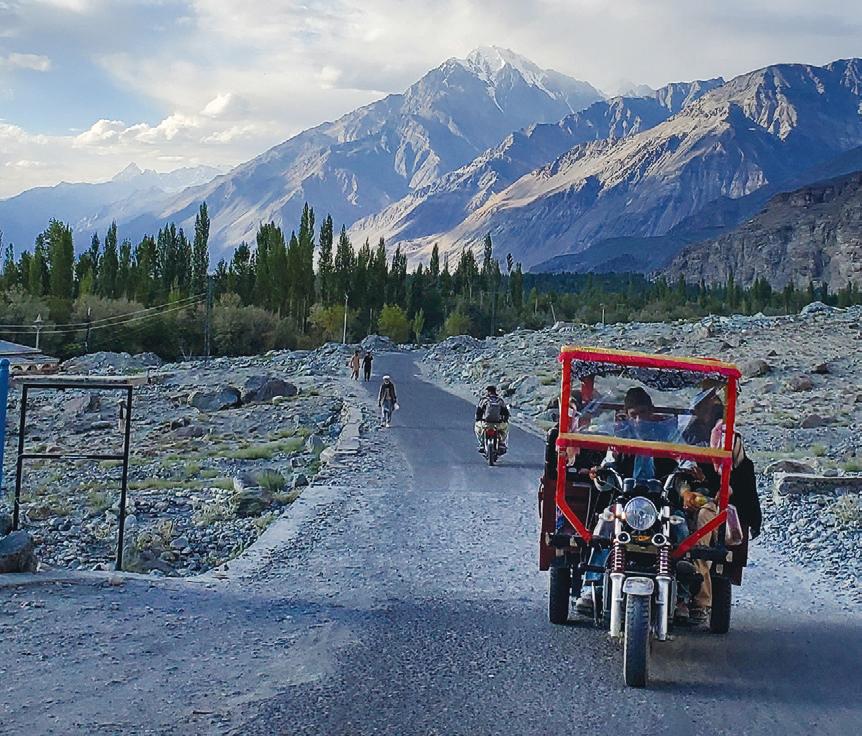
“Here you challenge the environment as it challenges you, and you grow as a motorcyclist because of it.” Rachel said with a smile.
While Deosai had pushed me to my limits, the looming reputation of our final destination, Shimshal, floated over our heads the entire trip. Tucked away in the Karakorum mountains, Shimshal is only accessible by the second most dangerous road in the world: Shimshal Valley road. Previously a donkey trail that took 18 years to transform into a dirt road just wide enough for a jeep or truck, it’s not for the faint hearted. Almost daily landslides threaten to erase sections of the road, but when parts slide away, the locals stack rocks underneath the fallen areas until its level again.
Shimshal Valley road is about a three-hour route of barely-there gravel roads giving way to sheer cliff drops into a rushing river below, with numerous suspension bridges, deep sand patches, and water crossings spread throughout. We were told it’s safer to ride on the cliff edge, since hugging the mountain risks having loose rocks knock you off. At the end of the road is Shimshal village, a community of farmers and mountaineers that have been living a simple life mostly untouched by the outside world.
Riding Shimshal was exhilarating and freeing, an intoxicating combination of fear and excitement that bleeds its way into any good adventure. Riding on the cliffside lets you see everything with stunning clarity, the miles of road and river that stretch ahead, unobscured by vehicles or signs of human interference. With every turn the sights and excitement just got better and better, a constant “I can’t believe I get to do this!” playing on repeat in my head. Before long my cheeks began to hurt in my helmet from the giddy smile I couldn’t get off my face.
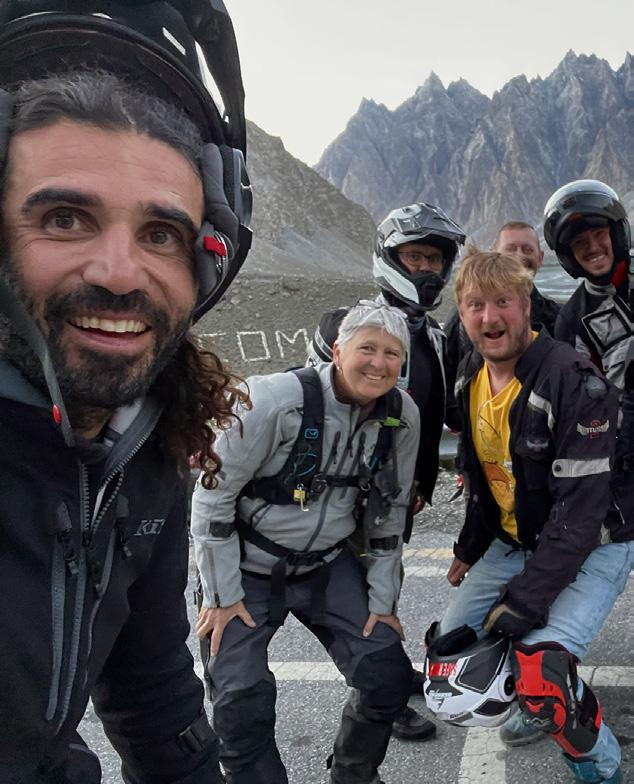
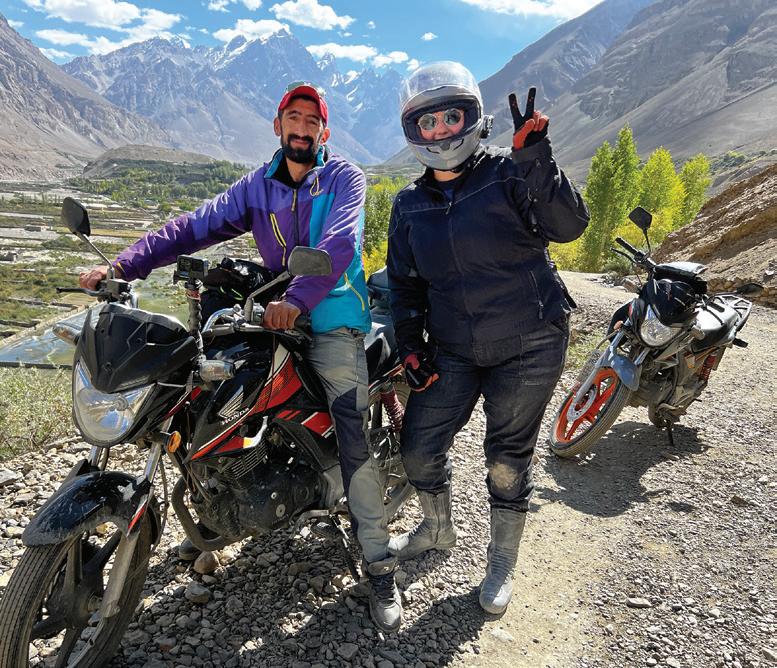
After riding for about three hours the road ends and the mountains open to a deep valley greeting you with a village that looks like it’s right out of a storybook. Cows, goats, and sheep litter the rolling farmland, while kids run around laughing and playing. It’s a perfect slice of paradise nestled in a mountain range; so picturesque it makes you overlook the harsh reality of the logistical nightmare of having Shimshal valley road be this village’s only access to actually attended 2022 AMA Vintage Motorcycle Days to speak about the ADA’s mission. News of his incredible trips have spread, and his name and impact has started receiving recognition for his positive influence on Pakistan’s foreign reputation. He’s been a key player in helping the country reestablish a strong tourism sector. the outside world. It’s moments like this that the second largest part of Moin’s trips come to light — charity work. As we were welcomed into the authentic experience of these local villages, Moin makes sure to give back tenfold to the communities that gift us with their hospitality. As beautiful as Shimshal Valley is, it is also a community that struggles to get essential needs met due to its remote and difficult location, only becoming accessible by vehicle two years ago.
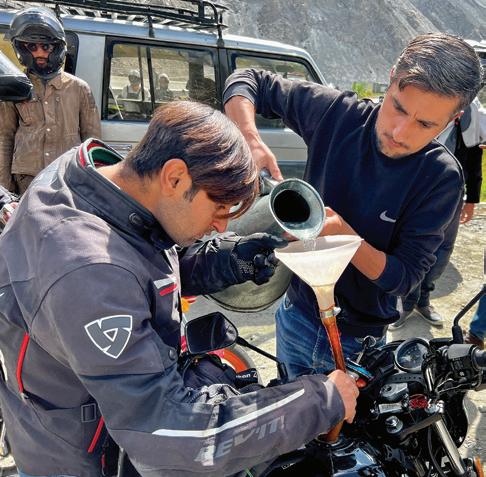
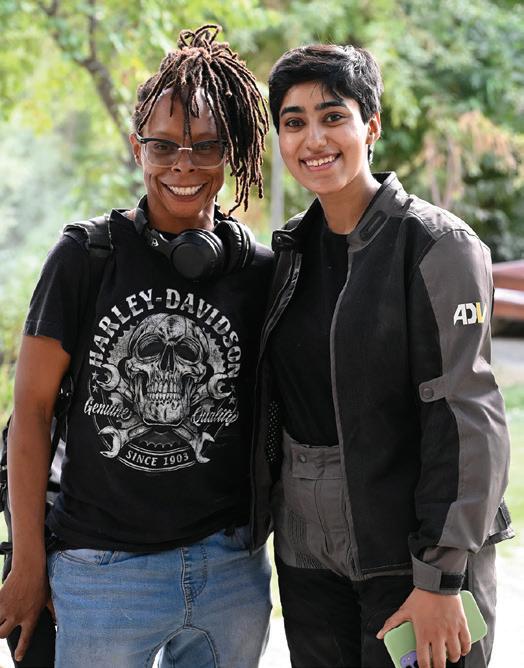
Atlas Honda bikes line the streets of Skardu City. Crime is so low in Pakistan that most people leave their bikes outside with the keys still in them. Right center: Hussn joins the excitement with her students at Shimshal Girls School aboard their new donated Atlas Hondas.
On the previous Chickistan trip, Moin took everyone to Shimshal Girls’ Hostel, a boarding school in the closest major town down in the mountain, Karimabad. It was founded by Hussn Bibi, the first girl from Shimshal to graduate high school and college. She was self-taught and had to hike three days down the mountain to take her tests and pass her grades. After getting her teaching degree, she opened her school so the rest of the girls from her village could have the opportunity to get a competitive education. As of today there are 80 girls living and studying there, with full room and board costing $250 per year.
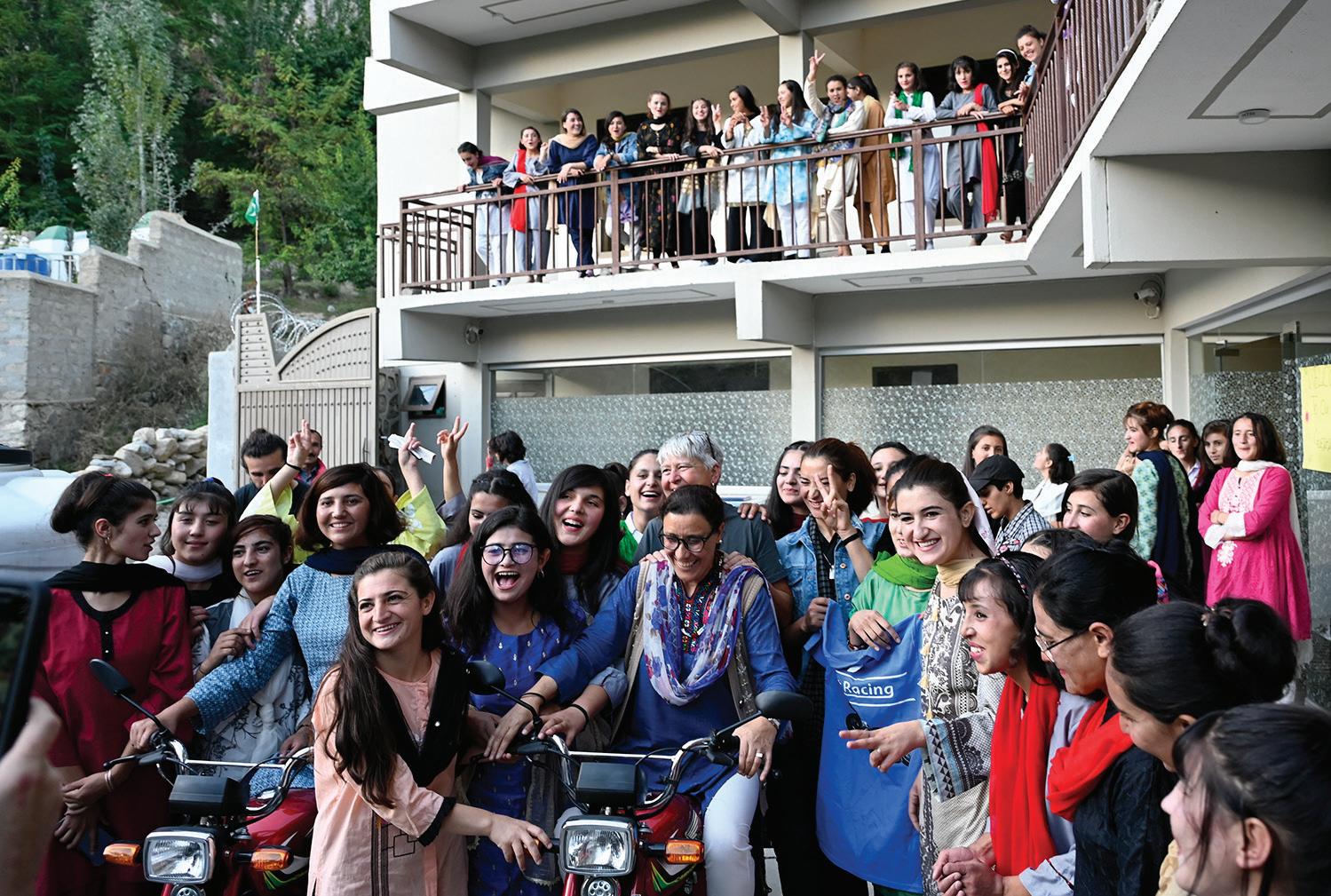
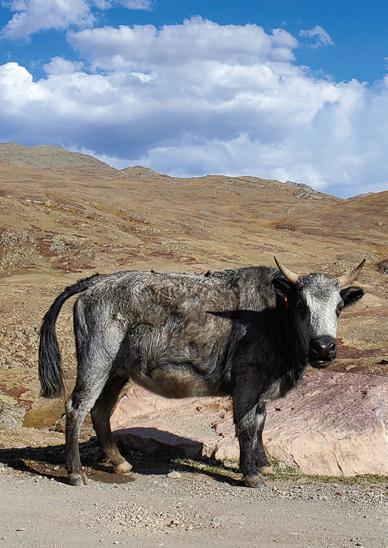
“She never turns anyone away,” Jaime Smith, another Chickistan alum, says, “she just makes money and food stretch further, and digs into her own pockets — which are not deep.”
Meeting Hussn and hearing her story had a deep impact on all of the women in the previous Chickistan group, and the ones returning wanted to give back. While Jaime and Lily raised $4,300 from friends and family to sponsor the education of 17 girls, Liza decided to pair up her podcast, Motorcycles and Misfits, with Maggie’s organization, Women Riders Now, to donate two brand- new motorcycles to the girls’ school.
In addition to the bikes, the returning women collected donated motorcycle gear, tool kits, and prepaid for one year of maintenance from a local mechanic to help the girls learn to take care of the motorcycles. Through these bikes, the girls can learn new skills, enjoy the freedom of movement, return to their homes more easily, and have immediate access to transportation in case of an emergency.
Aisha Aslam, a female motorcyclist and vlogger we met during one of our rides and who decided to join us for parts of our trip, has also committed to teaching the girls how to ride their new bikes.
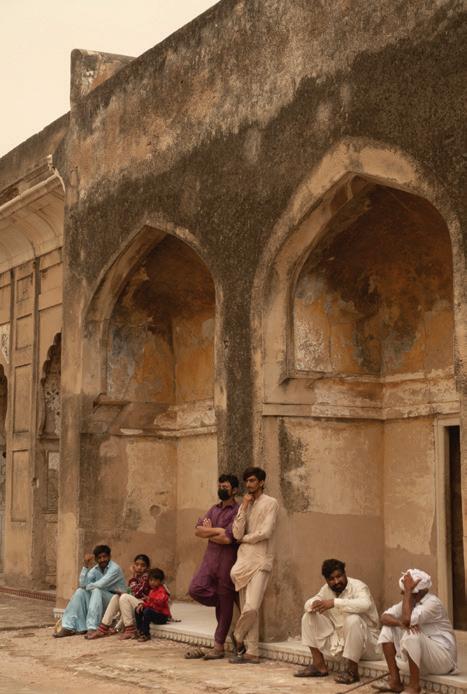
“There’s something very empowering about riding,” Aisha said, “Just because I ride, I get to help these girls from Shimshal, and that’s great in its own way.”
Seeing the girls’ faces light up after receiving the motorcycles reminded me of how I felt the first time I swung a leg over one. We put the bikes in neutral and popped them on the center stand so that the girls could take turns getting a feel for sitting on them and revving the engines. It quickly turned into classic teenage chaos, as every girl wanted to have a turn making the bikes roar.
“This is more than just survival,” Lili said. “We covered their basic needs, and now they get to have some fun.”
On the day we were scheduled to leave Shimshal, Jaime and I decided to depart earlier than the rest of the group so we could spend more time in the village. As we rode our bikes between the houses and fields, we stopped to speak with every person we saw. We got invited into one man’s family wheat mill, where we met his 80-yearold mountaineering father who was still minding the grain.
We also ran into the mother of one of the girls attending Shimshal Girls’ Hostel, who immediately asked us if we were the Americans who donated two motorcycles to her daughter’s school. Our conversation was filled with tears and thanks before she quickly introduced us to the rest of her family.
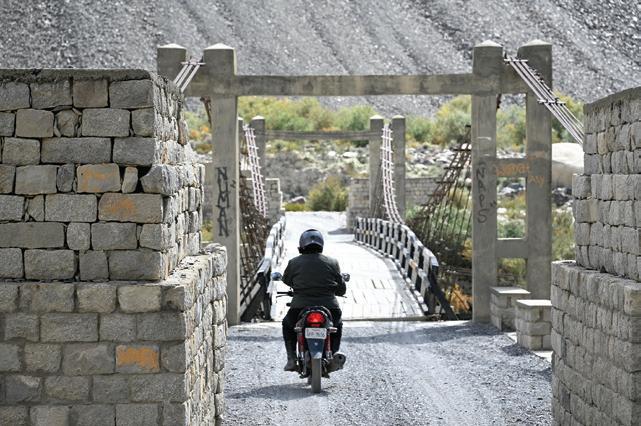
Riding through all of Shimshal Valley only took about an hour, even when stopping to speak with every road builder and mountaineer we saw. Each interaction was laced with the same continuing undertone of the trip: “thank you so much for coming and seeing the beauty of Pakistan.”
In addition to riding days, another highlight of the trip was when we were in villages for longer than 24 hours. My favorite was Karimabad, which is the capital of Hunza District and a beautiful mountain town nestled in the Hunza Valley.
Taking a break from the constant riding allowed us to relax and take our time walking through these historic towns. Shopkeepers would start up their generators as we walked past, clearly excited to meet us and show us their products. Normally, you expect to pay a “tourist tax” when traveling to another country, but often the exact opposite was the case in Pakistan.
“There were times last year where we would go to buy a Coke or a candy bar and they wouldn’t let us pay for it,” Rachel said.
I experienced this same level of generosity multiple times. Once, when I expressed interest in a bag that had a firm price tag on it, the owner of the store refused to take my money, saying that since I was a guest in his country, he couldn’t charge me. Eventually I convinced him to let me give him at least one third of the original price.
“Some places we had meals, it was difficult to pay.” Moin said, “People would be like, they’re your guests. They’re our guests. They’re Pakistan’s guests, so we can’t take money from you guys.”
After Shimshal, it was a mad dash back to Islamabad so we could make our flights. This is where we experienced the “crazy” traffic most people associate with Delhi or Mumbai. Defensive driving is not an option…if you’re not aggressive your spot quickly gets taken and you’ll get hit. Everyone assumes that others will take the initiative to just GO, which allows you to predict other vehicles’ movements easily. All of this, along with the added fact that honking is simply a regular “Hey! I’m here!” noise in Pakistan, made being in the heart of it surreal and exhilarating.
And if at any point someone was overwhelmed by the roads, Moin had a safety plan in action. Two support trucks followed us our entire journey, with full-time staff waiting to jump on anyone’s bike to give them a break from riding. Making Pakistan as fun and accessible as possible is Moin’s goal. With the diversity of Pakistan’s roads and nature, he can craft any adventure experience you could possibly want, from a fully paved riding trip to an off-road excursion.
“Pakistan has got to be on your bucket list,” Maggie — who’ll be leading the 2023 Chickistan tour — responded when I asked what she’d like to say to AMA members about the trip. “Plenty of incredible roads. You can go to China and India on paved roads if you don’t want to do dirt. Just get ahold of Moin, tell him what you want, and he’ll take really good care of you.”
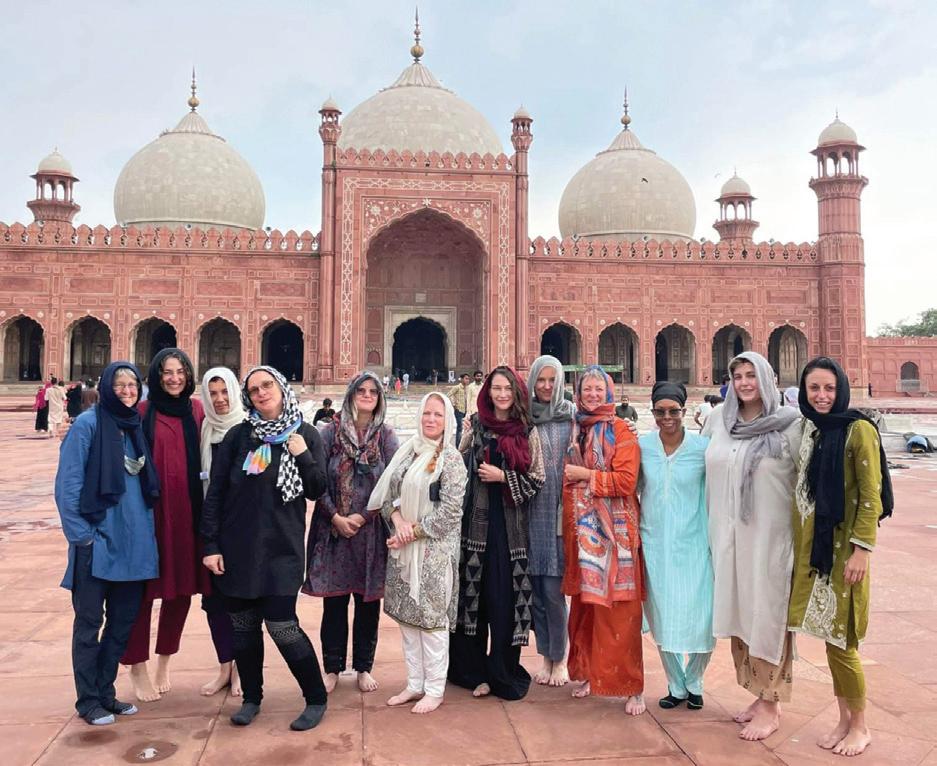
Moin’s passion for his country, motorcycles, and the gift of life is infectious, and his mindset rings universally true: “all you need to do is find the motorcyclists, and adventure is inevitable.”
After landing back in the States, I can confidently say that my world view has changed for the better. Over the course of those two-and-a-half weeks I grew into a significantly better rider and traveler. Pakistan truly is the destination we’ve all been missing out on. With breathtaking scenery, exhilarating roads, preserved culture and history, and an incredibly favorable exchange rate to the American dollar, Pakistan is the best kept secret you need to get in on.
“Everyone you meet so clearly wants the world’s perception changed,” Rachel said. “And I think us coming helps that cause. We’re taking these stories home and educating our own people, and that’s the most important part of these trips.”
As someone lucky enough to get to work in the motorcycle world, I am constantly in awe of the power and influence of the motorcycling community. Motorcyclists are a special breed, all walks of life brought together by the simple joy of sharing a passion for a machine that allows us to fly. From small-town charity events to bolstering the tourism sector and reputation of an entire country, when motorcyclists come together, magic always happens.
Still not convinced about Pakistan’s worthiness as an epic destination? Shoot me an email at grassroots@ ama-cycle.org. If you want to figure out how to take the trip of a lifetime, visit adifferentagenda.com
Erin Reda is the AMA’s Grassroots Coordinator in the AMA’s Government Relations Department in Washington, D.C. AMA
“If you put every national park in the USA back to back, that’s what riding through Pakistan is like. But most people who go there end up saying that the thing they liked most was the culture and people they met along the way.”
LIZA MILLER
If you find yourself driving by the “Point of the Mountain” on I-15 in Draper, Utah, these days, you’d have a hard time discerning what happened on the massive, 1,000-foot-tall hillside just east of the freeway during the ’60s, ’70s and ’80s.
But if you know where to look, you can still trace a handful of semi-overgrown vertical grooves running up the 45-degree, milewide hillside that, for more than two decades, hosted the legendary Widowmaker Hillclimb. Widowmaker was ground zero for a movement that stretched back to the earliest days of motorcycling and motorcycle competition — and was recorded so wonderfully in Bruce Brown’s epic moto documentary On Any Sunday back in 1970.
“It’s Sunday, and we’re about 20 miles from Salt Lake City, Utah. There’s a hill there called Widowmaker; it’s 600 feet high, and the angle up the face is 89 percent, roughly 45 degrees. It’s the site of the annual Widowmaker Hillclimb. No one’s ever made it over the top, and they’ve been trying for seven years. Riders come from all over the country to compete in yet another highly specialized form of motorcycle competition. As I said, no one’s ever made the top, but they give it a helluva try.”
Remember Brown’s voice-over? Of course you do.
Draper Hill History
Twenty thousand years ago, even the most imaginative cave dweller couldn’t have conjured it, as the









